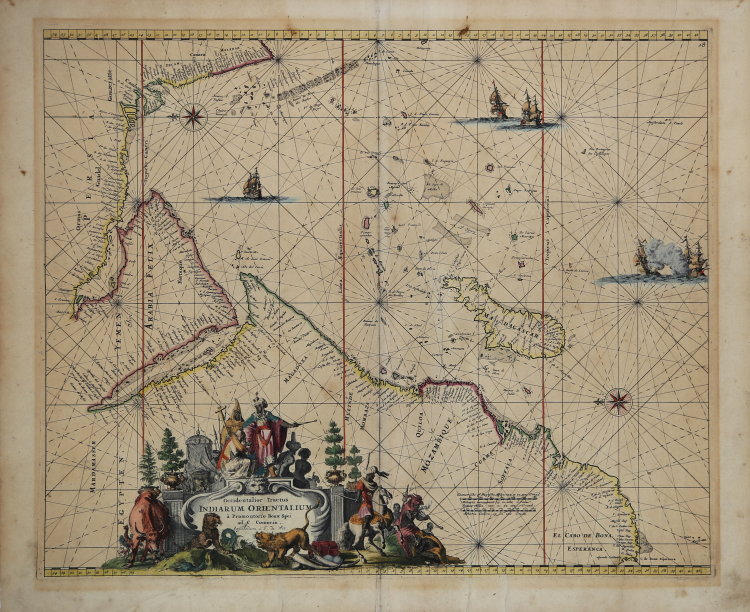



| Reference: | AF3629 |
| Author | Frederick de WIT |
| Year: | 1680 ca. |
| Zone: | Indian Ocean |
| Printed: | Amsterdam |
| Measures: | 555 x 450 mm |


| Reference: | AF3629 |
| Author | Frederick de WIT |
| Year: | 1680 ca. |
| Zone: | Indian Ocean |
| Printed: | Amsterdam |
| Measures: | 555 x 450 mm |
A highly decorative, large sea chart of the East Coast of Africa with Madagascar, the Arabian Peninsula, and the Malabar Coast of India. This was an important region as it depicts an area heavily contested among the Portuguese, Dutch, English, and other European powers, and with its Arab settlements that were in this area from earliest times.
This sea chart was first published in De Wit's Orbis Maritmus ofte Zee Atlas of 1675 and appeared in later editions as well. De Wit's sea charts from his Zee Atlas are sought after for their geographical content as well as their attractive cartouches and vignettes.
A large, elaborate title cartouche dominates the bottom of the chart.
This cartouche shows animals: lions, water Buffalo, snakes, and other animals. Across the top of the cartouche are numerous Arabs, one on horseback. Several sea battles are also depicted in the Indian Ocean.
Copper engraving, magnificent contemporary colour, signs of centre fold, otherwise in good condition. Reference: Norwich Map, 256.
|
Norwich, The Map of Africa, 256. Dimensioni 555x450
|
Frederick de WIT (1630 - 1706)
|
De Wit was one of the most prominent and successful map engravers and publishers in Amsterdam in the period following the decline of the Blaeu and Jansson establishments, from which he acquired many copper plates when they were dispersed at auction. His output covered most aspects of map making: sea charts, world atlases, an atlas of the Netherlands, 'town books' covering plans of towns and cities in the Netherlands and Europe, and wall maps. His work, notable for the beauty of the engraving and colouring, was very popular and editions were issued many years after his death by Pieter Mortier and Covens and Mortier.
|
|
Norwich, The Map of Africa, 256. Dimensioni 555x450
|
Frederick de WIT (1630 - 1706)
|
De Wit was one of the most prominent and successful map engravers and publishers in Amsterdam in the period following the decline of the Blaeu and Jansson establishments, from which he acquired many copper plates when they were dispersed at auction. His output covered most aspects of map making: sea charts, world atlases, an atlas of the Netherlands, 'town books' covering plans of towns and cities in the Netherlands and Europe, and wall maps. His work, notable for the beauty of the engraving and colouring, was very popular and editions were issued many years after his death by Pieter Mortier and Covens and Mortier.
|